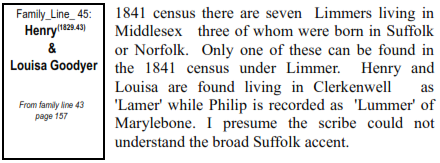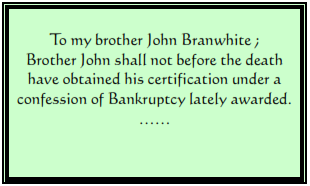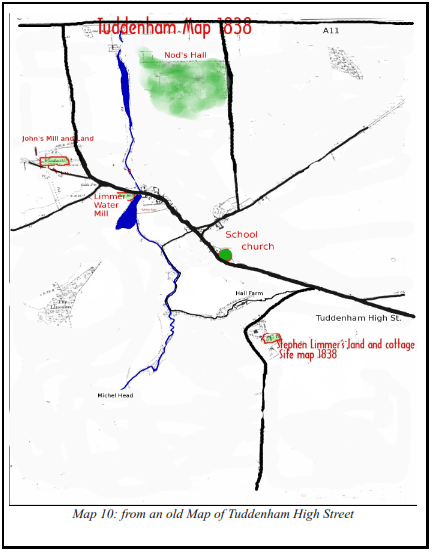Chapter 16 The Tuddenham Era
Background
 t the turn of 1700 AD, Tuddenham had around 100 inhabitants. This rose to 268 by the 1801 census 481 by A1851 and back down to 329 by 1891.
t the turn of 1700 AD, Tuddenham had around 100 inhabitants. This rose to 268 by the 1801 census 481 by A1851 and back down to 329 by 1891.

There is evidence that some Limmers were educated to a high degree, as it appears John(1776.49) was the accountant and executor of Tuddenham Water mill at the time of his fathers’ death. Limmers of Tuddenham seem to be as closely knitted in death as in life. The church graveyard map below, plotted in August 1981, marks the fading headstones. Limmers are in two rows immediately to the right as you go through the gate.

1. A large Monument and foot-stone denotes the grave of Stephen(1743.46) who died June 11th 1818 aged 75. He is buried with his wife Elizabeth who died 5th May 1807 aged 58.
2. A tome-stone head marks the spot for Philip Limmer who died December 19th 1833 aged 78.
3. A simple headstone and foot-stone marks William Limmer. The weather beaten stone is hardly readable but commemorates William Limmer who died 1771.
4. John(1776.49) has a headstone and foot stone.
5. And finally a family headstone in memory of William, Diana, (wife of William), and four of their children Frances(1776.49) George(1771.49) Susan(1772.49) and William(1774.49).
Henry(1829.43) Henry married Louisa Goodyer 16th April 1854 in Clerkenwell. Louisa was born in Lincolnshire in 1831, and moved with her family to Clerkenwell around 1840.
Henry(1829.43) and Philip(1810.43) mark the start of Suffolk Limmer's migration into the East end of London. One or two Limmers had made their way to London before this time but they had kept a house for retreating to the mother county. Now, with harder times and less wealth in the family, the ties are being cut. According to the

One other mystery person appears in the Tuddenham story. Thomas Limmer is mentioned several times in the context of William (Miller) Limmer. Thomas insured the windmill at Tuddenham in 1788 and held the lease of the water mill in 1801. Thomas is also mentioned in the context of James Limmer of Bury-Saint-Edmunds. This mysterious Thomas, obviously a man of money, appears and disappears in the Limmer story but he leaves behind a hint of relationship between the Bury Limmers and Tuddenham Limmers. He may have been cousin to both nuclear families having descended from either William(1714.U) or Samuel(1789.U) of Norfolk. There are several Thomas' documented in the Limmer line but none seem to fit this Thomas.
There were three Mills - two windmills and a watermill in Tuddenham. The Marquis of Bristol owned the land Tuddenham water mill stood on, though the mill belonged to the Limmer family who leased the land. A watermill on this site is mentioned in the doomsday book. The mill, almost as the Limmers knew it, still exists today as a hotel and restaurant. It ceased grinding corn in 1956.

The second Mill is smock mill marked in Hodskinsons map about two miles from the water mill on the main road just outside Little Barton. The third, a wooden clad post mill about half of a mile from the water mill on the Barton Mills road.
John(1703.42) Son of John(1672.39) and Elizabeth, did not follow his father into the clothing industry but became a Yeoman,242 moving from the corn/maize farms of Chevington and Herringswell to the more general farms of Tuddenham, somewhere between 1737 and 1739 (between the birth of their children Edward(1737.46) and Mary(1739.46).

John also leased a smallholding from the Marquis of Bristol, a piece of land about half a mile from Tuddenham water mill. It is on this land John had the post mill was built for his son William(1733.46). By the time William(1733.46) married Diana in 1762, he was known locally as William ‘the miller’ Limmer.
William(1733.46) Limmer insured ‘ the goods in trade at the water mill’ and “his windmill built and boarded”243 for £100 on the 9th April 1776. As this is the earliest record of the insurance company, we cannot tell if John(1703.42) miller had water mill and the post mill before this date. The cost of building the windmill gives the clue that it was a wooden clad post mill rather than a brick based one.
Assuming John was insured with another company before he took out a policy with the Royal Exchange, on the 4th November 1795, he had reason to claim on his insurance. The sail of the mill was “feloniously taken” 244 on Monday night or early Tuesday morning (the 12 / 13th day of October ) the Bury and Norwich Post records “a certain sailcloth belonging to William Limmer being stolen. William Limmer offered two guineas for information leading to conviction of these villainous fellows”.
William, feeling his age at fifty-five, allowed Thomas Limmer to take charge, closely holding together a family concern until William’s death at the water mill in 1788. Both water mill and windmill were working during this time but harder times were around the corner.
The corn failures of 1795 and 1800 did little to help millers at this time. The lease had to be paid because the Marquis of Bristol was not a sympathetic sort of person when it came to money. The three hundred year lease on the land and mills expired after 1801 and the land was due to revert to the manorial estate.
Whether the Marquis of Bristol decided to sell the mill before or after the lease ran out in 1801, we may never know, but it certainly seems to have worried William. We get a hint that John Branwhite245 and John(1776.49) 246 also had invested interest in the

business. When William died in 1801 these two, become executors, winding up the business and executing William’s will.
John Branwhite, was declared bankrupt in 1801247. His sister died the same year. According to her will, which Eleanor of Lavenham, had signed on 25 November 1801, her brother Richard and John Dunningham were ordered to sell all her interests and her personal fortune dividing the proceeds of the sale five ways. John was not to receive his share until his bankruptcy period lapsed. The monies to be held by his brothers in a trust.
Who bought the post mill belonging to the late William miller? It seems it was kept in the family for better times. Son John(1776.49) seems to have raised a mortgage for it. It was certainly in his possession at the time of his death as he left it in his will. William also left considerable properties in Mildenhall, Brandon and Tuddenham so the crop failure did not completely bankrupt him.
William(1733.46) was obviously a newsworthy person as the Bury and Norwich news carried the news of his death in July 1801.
The mill and other parts of the farm were sold and the proceeds divided equally among four children John(1776.49), Ann(1782.49) (who married John Branwhite the year her father died), Prudence(1764.49) and Frances(1767.49). these were the only four children to outlive their father. Susanna, died the same year.
John(1776.49) brought the Farm at Little Barton with his share immediately after his father’s death, where he erected another smock mill. It appears that he borrowed money from John Branwhite before his bankruptcy. John(1776.49) over did the credit to build a Mill on top of buying a farm. Within one year of building the new smock mill, the Sheriff ordered him to sell in order to cover his debts. Once again, Bury and Norwich post carries the story.248
John(1776.49) leased a piece of land from John Turner of Rectory after the sale and his father’s death less than a year later. He carried on farming, probably livestock, as the land immediately around the mill being too rough to plant cereal. John(1776.49) still came off better than John Branwhite, as it appears he kept one of the two post mills and continued milling until his death in 1806.
The other post windmill and the watermill work closely together until 1844. What happened to Thomas Limmer after the lease ran out in 1801 we do not know. To complete the story of the water mill, Thomas Steel bought the mill then died in 1838 leaving it to his son Thomas Steel Junior.
Thomas Steel Junior converted the water mill to steam in 1844. This was the demise of the windmill industry as the steam mill could handle all the local corn demands. It reverted to the Marquis of Bristol in 1866, again under the terms of a shorter lease on the land taken out in 1801, and changed hands several times after this. The mill actually stopped working in 1956, converted to a high-class conference centre still holding conferences today.
By the 1851 census, there are no Limmers found in Tuddenham (although two were buried there after this date).










 t the turn of 1700 AD, Tuddenham had around 100 inhabitants. This rose to 268 by the 1801 census 481 by A1851 and back down to 329 by 1891.
t the turn of 1700 AD, Tuddenham had around 100 inhabitants. This rose to 268 by the 1801 census 481 by A1851 and back down to 329 by 1891.










